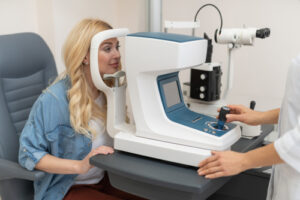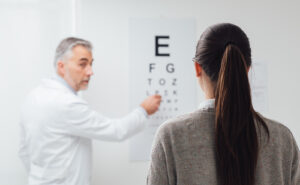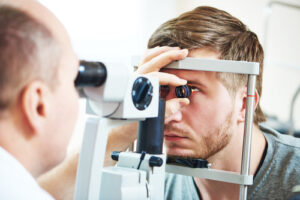Is it time for your next eye exam? Regular eye exams are essential to keeping your eyes healthy.
The American Academy of Ophthalmology recommends checking your eyes regularly. Our doctors suggest starting with your first eye exam at 6-12 months of age (through the InfantSEE program free of charge), then an exam at ages 3 and 5 then every year after that.
Your optometrist may recommend more frequent eye exams if you have eye-related conditions, wear contact lenses, or have certain risk factors like diabetes or a family history of eye disease. An eye exam involves more than dilating your pupils and ensuring your prescription hasn’t changed.
Over about an hour, your optometrist will thoroughly evaluate every aspect of your eyes to ensure they are healthy. Keep reading to find out what to expect at your comprehensive eye health exam!
An Optometric Technician Will Gather Information for the Eye Doctor
Before you meet with your optometrist, a technician will first note any concerns or changes to your vision you may have noticed. Once they have this information, they will review your detailed medical history.
You’ll discuss your eyes, as well as how healthy you are. Certain conditions can increase your risk of developing eye conditions. They need to be aware of any other medical conditions you may have.
They will also ask you about any medications you may be taking. Prescription medications can have side effects, like dryness. They can also raise your likelihood of developing an eye condition or infection.
Besides going over your personal medical information, they will also ask for detailed information about your family medical history. Your family history can influence what eye conditions you’re most likely to develop. For example, cataracts, macular degeneration, and glaucoma can all run in families.

After gathering your medical history, the technician will measure your visual acuity. They will use a piece of equipment called a computerized autorefractor to determine your refractive error. This is a starting point for evaluating your vision.
You’ll also have your blood pressure taken, as high blood pressure can increase your risk of certain eye conditions. In addition, they will test your peripheral vision for signs of glaucoma. In its early stages, glaucoma affects your peripheral vision, which you may not even notice.
They will convey all this information to your eye doctor to ensure they are well-informed during the rest of your eye exam.
Your Eye Doctor Will Test Your Vision and Determine Your Prescription

One of the central parts of an eye exam is reading off an eye chart called a Snell chart. The Snell chart contains lines of different-sized letters.
Your optometrist will ask you to read off the chart, covering one eye at a time. Covering one eye at a time will test how well you can see objects at various distances and whether you have 20/20 vision.
The next part involves looking at another eye chart through a phoropter. The phoropter has lenses with a range of focusing powers.
Your eye doctor will ask you which lens allows you to see better. They will then be able to determine your prescription.
They Will Check for Signs of Eye Disease

When it comes to treating eye disease, early diagnosis and treatment are critical. Many times, patients can have an eye condition without realizing it.
Some eye conditions like glaucoma have few, if any, noticeable symptoms before irreversible vision loss. A comprehensive eye exam will check you for early signs of various conditions. These include cataracts, glaucoma, macular degeneration, and diabetic retinopathy.
You may be familiar with dilating your eyes during an eye exam, but do you know why it’s performed? By widening your pupil, your optometrist can more closely examine your retina and optic nerve.
These two essential structures can show signs of disease or other concerning eye conditions. Your eye contains many unique structures.
These must work together to provide clear vision. In addition to your retina and optic nerve, your optometrist will look closely at your pupils, eye muscles, and the front part of your eye.
They can only access these parts of your eye by dilating your eyes. There are a variety of tests that your optometrist may use during an exam. They may shine a light into your eye to ensure that your pupil responds appropriately.
The pupil should react to the light shining by shrinking and growing smaller. They can also use a slit-lamp microscope to illuminate the front part of the eye. Illuminating the front of the eye makes it possible to examine the eyelids, cornea, iris, and lens.
They will evaluate how your eyes move while checking to ensure they align with each other. They will check your eye pressure using a painless blue light. Increased eye pressure can be a symptom of glaucoma.
Eye exams are the best means of preventing or diagnosing an eye condition. Your eye doctor can stop symptoms from developing or progressing by spotting signs and intervening early.
If you find out you have an eye condition, early diagnosis is best because it leads to the earliest possible treatment. Early treatment is crucial for irreversible eye conditions that cause vision loss, like glaucoma. Your optometrist is here to ensure your eyes are healthy and will stay that way in the years to come.
Does it feel like it’s been too long since you saw an eye doctor or scheduled an eye exam to get your eyes checked? Start making your vision a priority by scheduling an appointment at Blaine Eye Clinic in Blaine, MN!
You only get one set of eyes, so isn’t it time to treat them like they matter?





